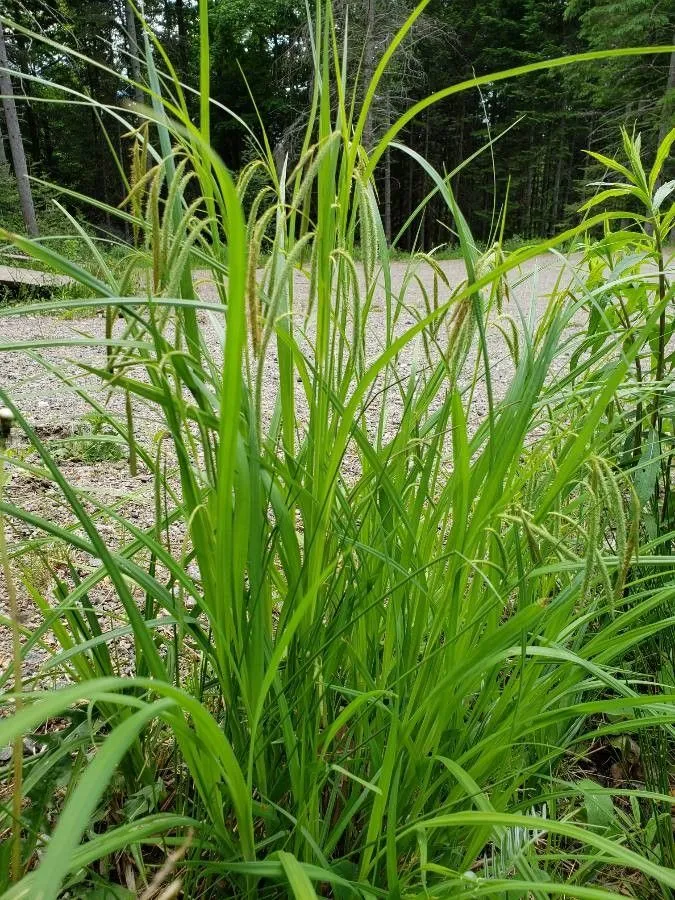
Author: Lam.
Bibliography: Encycl. 3: 393 (1792)
Year: 1792
Status: accepted
Rank: species
Genus: Carex
Vegetable: False
Observations: C. & E. Canada to C. & E. U.S.A.
Fringed sedge, scientifically known as Carex crinita, is an integral species within the Cyperaceae family. Historically acknowledged and described in the year 1792, the formal scientific nomenclature and documentation of this species can be traced back to the pioneering work featured in the third volume of the “Encyclopédie Méthodique: Botanique,” a comprehensive botanical reference from that period. This notable documentation was accomplished by the prominent botanist Lam.
Native to the diverse ecosystems of Central and Eastern Canada and the United States, Carex crinita thrives in a variety of moist habitats, including wetlands, marshes, and along streams and lakeshores. Its natural distribution underscores its adaptability and ecological importance across different regions characterized by temperate climates.
Characterized by its distinct fringed, or hairy, appearance, the fringed sedge is easily recognizable. It displays slender, arching leaves and elongated, pendulous seed heads which give it a unique presence among sedges. The plant’s structure not only contributes to its ornamental appeal but also serves essential ecological functions. It provides critical habitat and food for various wildlife, including birds and small mammals, thereby supporting local biodiversity.
The fringed sedge’s ability to establish in wet, often unstable soil conditions makes it an invaluable species for erosion control and water filtration. By stabilizing soil with its extensive root systems and trapping sediments and pollutants in water, this sedge contributes significantly to the health and resilience of wetland ecosystems.
As an important member of the sedge family, Carex crinita is also of considerable interest for environmental restoration projects. Its role in promoting biodiversity and maintaining the integrity of aquatic environments highlights its ecological significance. Whether as a component of natural landscapes or in managed habitats, the fringed sedge stands out for its multifaceted contributions to both nature and human interests.
In summary, Carex crinita, or fringed sedge, is a botanically and environmentally valuable species within the Cyperaceae family, celebrated for its unique appearance and its crucial role in supporting and maintaining healthy wetland ecosystems across Central and Eastern North America.
Eng: fringed sedge
Fra: carex crépu
En: Fringed sedge
Fr: Carex crépu
Taken Jun 4, 2008 by EOL − Chicago Botanic Garden 2008 (cc-by-nc-sa)
Taken Jun 4, 2008 by EOL − Chicago Botanic Garden 2008 (cc-by-nc-sa)
Taken Jan 1, 1900 by EOL − John Hilty (cc-by-nc)
Taken Jun 25, 2022 by Raymond Gagnon (cc-by-sa)
Taken Jul 12, 2021 by Kal Soong (cc-by-sa)
Taken Jun 15, 2021 by Richard Wilkens (cc-by-sa)
Taken May 30, 2021 by David Koser (cc-by-sa)
Taken Aug 12, 2010 by EOL − Kirchner, Natalie (cc-by-nc-sa)
Taken Jan 1, 1900 by EOL − USDA NRCS Wetland Science Institute. (public)
Taken Jul 12, 2021 by Kal Soong (cc-by-sa)
Taken Oct 14, 2013 by EOL − Christopher Tracey (cc-by-nc-sa)
Taken Jan 1, 1900 by EOL − John Hilty (cc-by-nc)
Taken Aug 12, 2010 by EOL − Kirchner, Natalie (cc-by-nc-sa)
Taken Aug 12, 2010 by EOL − Kirchner, Natalie (cc-by-nc-sa)
Taken Jun 18, 2019 by Matt (cc-by-sa)
Taken Jun 18, 2019 by Bianca Legault (cc-by-sa)
Taken Jun 4, 2008 by EOL − Chicago Botanic Garden 2008 (cc-by-nc-sa)
Taken May 21, 2013 by EOL − Robert L Curtis (cc-by-nc-sa)
Taken Jun 4, 2008 by EOL − Chicago Botanic Garden 2008 (cc-by-nc-sa)
Taken May 25, 2012 by EOL − Everett (cc-by-nc-sa)
Taken Jul 11, 2013 by EOL − Jesse Lincoln (cc-by-nc)
Taken Aug 12, 2010 by EOL − Kirchner, Natalie (cc-by-nc-sa)
Taken Aug 12, 2010 by EOL − Kirchner, Natalie (cc-by-nc-sa)
Growth form>: Bunch
Growth habit>: Graminoid
Growth rate>: Moderate
Ph maximum: 7.5
Ph minimum: 4.0
Family: Myrtaceae Author: (F.Muell.) K.D.Hill & L.A.S.Johnson Bibliography: Telopea 6: 402 (1995) Year: 1995 Status:…
Family: Rubiaceae Author: Pierre ex A.Froehner Bibliography: Notizbl. Bot. Gart. Berlin-Dahlem 1: 237 (1897) Year:…
Family: Sapindaceae Author: Koidz. Bibliography: J. Coll. Sci. Imp. Univ. Tokyo 32(1): 38 (1911) Year:…
Family: Asteraceae Author: A.Gray Bibliography: Pacif. Railr. Rep.: 107 (1857) Year: 1857 Status: accepted Rank:…
Family: Fabaceae Author: Medik. Bibliography: Vorles. Churpfälz. Phys.-Ökon. Ges. 2: 398 (1787) Year: 1787 Status:…
Family: Aspleniaceae Author: (Cav.) Alston Bibliography: Bull. Misc. Inform. Kew 1932: 309 (1932) Year: 1932…